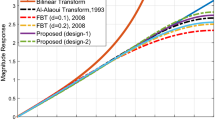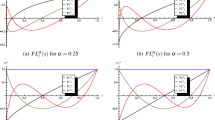Abstract
Applications of fractional-order operators are growing rapidly in various branches of science and engineering as fractional-order calculus realistically represents the complex real-world phenomena in contrast to the integer-order calculus. This paper presents a novel method to design fractional-order differentiator (FOD) operators through optimization using Nelder–Mead simplex algorithm (NMSA). For direct discretization, Al-Alaoui operator has been used. The numerator and the denominator terms of the resulting transfer function are further expanded using binomial expansion to a required order. The coefficients of z-terms in the binomial expansions are used as the starting solutions for the NMSA, and optimization is performed for a minimum magnitude root-mean-square error between the ideal and the proposed operator magnitude responses. To demonstrate the performance of the proposed technique, six simulation examples for fractional orders of half, one-third, and one-fourth, each approximated to third and fifth orders, have been presented. Significantly improved magnitude responses have been obtained as compared to the published literature, thereby making the proposed method a promising candidate for the design of discrete FOD operators.























Similar content being viewed by others
References
K. Assaleh, W. M. Ahmad, Modeling of speech signals using fractional calculus, in Proceedings of 9th International Symposium on Signal Processing and Its Applications, (ISSPA’07), Sharjah, UAE (2007)
Z.J. Bortolot, An adaptive computer vision technique for estimating the biomass and density of loblolly pine plantations using orthophotography and LiDAR imagery., Doctorate thesis. Virginia Polytechnic Institute and State University, Virginia (2004)
Y.Q. Chen, K.L. Moore, Discretization schemes for fractional-order differentiators and integrators. IEEE Trans. Circuits Syst. I Fundam. Theory Appl. 49(3), 363–367 (2002)
Y.Q. Chen, I. Petras, D. Xue, Fractional order control—a tutorial, in Proceedings of the American Control Conference (ACC ’09), Logan, UT, USA, pp. 1397–1411 (2009)
Y.Q. Chen, B.M. Vinagre, A new IIR-type digital fractional order differentiator. Signal Process. 83(11), 2359–2365 (2003)
Y.Q. Chen, B.M. Vinagre, D. Xue, V. Feliu, Fractional order Systems and Controls: Fundamentals and Applications (Springer, London, 2010)
S. Das, B. Majumder, A. Pakhira, I. Pan, S. Das, A. Gupta, Optimizing continued fraction expansion based IIR realization of fractional order differ-integrators with genetic algorithm, in Proceedings of Process Automation, Control and Computing (PACC) International Conference, Coimbatore 20–22 July, 2011, pp. 1–6 (2011)
L. Debnath, Recent applications of fractional calculus to science and engineering. J. Math. Math. Sci. 54, 3413–3442 (2003)
Z.E.A. Fellah, C. Depollier, Application of fractional calculus to the sound waves propagation in rigid porous materials: validation via ultrasonic measurement. Acta Acust. 88(1), 34–39 (2002)
N.M. Fonseca Ferreira, F.B. Duarte, M.F.M. Lima, M.G. Marcos, J.A. Tenreiro Machado, Application of fractional calculus in the dynamical analysis and control of mechanical manipulators. Fract. Calc. Appl. Anal. 11(1), 91–113 (2008)
M. Gupta, P. Varshney, G.S. Visweswaran, Digital fractional-order differentiator and integrator models based on first-order and higher order operators. Int. J. Circuit Theory Appl. 39(5), 461–474 (2011)
B.T. Krishna, Studies on fractional order differentiators and integrators: a survey. Signal Process. 91(3), 386–426 (2011)
V.V. Kulish, J.L. Lage, Application of fractional calculus to fluid mechanics. J. Fluids Eng. 124(3), 803–806 (2002)
J.C. Lagarias, J.A. Reeds, M.H. Wright, P.E. Wright, Convergence properties of the Nelder–Mead simplex method in low dimensions. SIAM J. Optim. Soc. Ind. Appl. Math. 9(1), 112–147 (1998)
G. Maione, A rational discrete approximation to the operator \(\text{ s }^{0.5}\). IEEE Signal Process. Lett. 13(3), 141–144 (2006)
B. Mathieu, P. Melchior, A. Oustaloup, C. Ceyral, Fractional differentiation for edge detection. Signal Process. 83(11), 2421–2432 (2003)
M.D. Ortigueira, An introduction to the fractional continuous-time linear systems: the 21st century systems. IEEE Circuits Syst. Mag. 147(1), 19–26 (2000)
S.K. Saha, S.P. Ghoshal, R. Kar, D. Mandal, Cat swarm optimization algorithm for optimum linear phase FIR filter design. ISA Trans. 52, 781–794 (2013)
R. Sharma, K.P.S. Rana, V. Kumar, Performance analysis of fractional order fuzzy PID controllers applied to a robotic manipulator. Expert Syst. Appl. 41(9), 4274–4289 (2014)
H. Sheng, Y.Q. Chen, FARIMA with stable innovations model of Great Salt Lake elevation time series. Signal Process. 91(3), 553–561 (2011)
H. Sheng, Y.Q. Chen, T.S. Qiu, Fractional Processes and Fractional-Order Signal Processing (Springer, London, 2012)
J.I. Suarez, B.M. Vinagre, A.J. Calderon, C.A. Monje, Y.Q. Chen, Using fractional calculus for lateral and longitudinal control of autonomous vehicles, in Computer Aided System Theory (EUROCAST 2003), pp. 337–348, (2003). doi:10.1007/978-3-540-45210-2_31
A. Tofighi, H.N. Pour, Expansion and the fractional oscillator. Phys. A 374(1), 41–45 (2007)
B.M. Vinagre, Y.Q. Chen, I. Petras, Two direct Tustin discretization methods for fractional-order differentiator/integrator. J. Frankl. Inst. 340(5), 349–362 (2003)
G.S. Viswesaran, P. Varshney, M. Gupta, New approach to realize fractional power in z-domain at low frequency. IEEE Trans. Circuits. Syst. II Express Briefs 58(3), 179–183 (2011)
R.E. Walpole, R.H. Myer, S.L. Myer, K. Ye, Probability and Statistics for Engineers and Scientists (Macmillan, New York, 1978)
M.H. Wright, Nelder, Mead, and the Other Simplex Method, Documenta Mathematica, Extra Volume: Optimization Stories (ISMP, 2012), pp. 271–276
R. Yadav, M. Gupta, Design of fractional order differentiators and integrators using indirect discretization approach, in Proceedings of International Conference on Advances in Recent Technologies in Communication and Computing, (ARTCom’ 10), Kottayam, Kerala (2010)
Author information
Authors and Affiliations
Corresponding author
Rights and permissions
About this article
Cite this article
Rana, K.P.S., Kumar, V., Garg, Y. et al. Efficient Design of Discrete Fractional-Order Differentiators Using Nelder–Mead Simplex Algorithm. Circuits Syst Signal Process 35, 2155–2188 (2016). https://doi.org/10.1007/s00034-015-0149-7
Received:
Revised:
Accepted:
Published:
Issue Date:
DOI: https://doi.org/10.1007/s00034-015-0149-7




